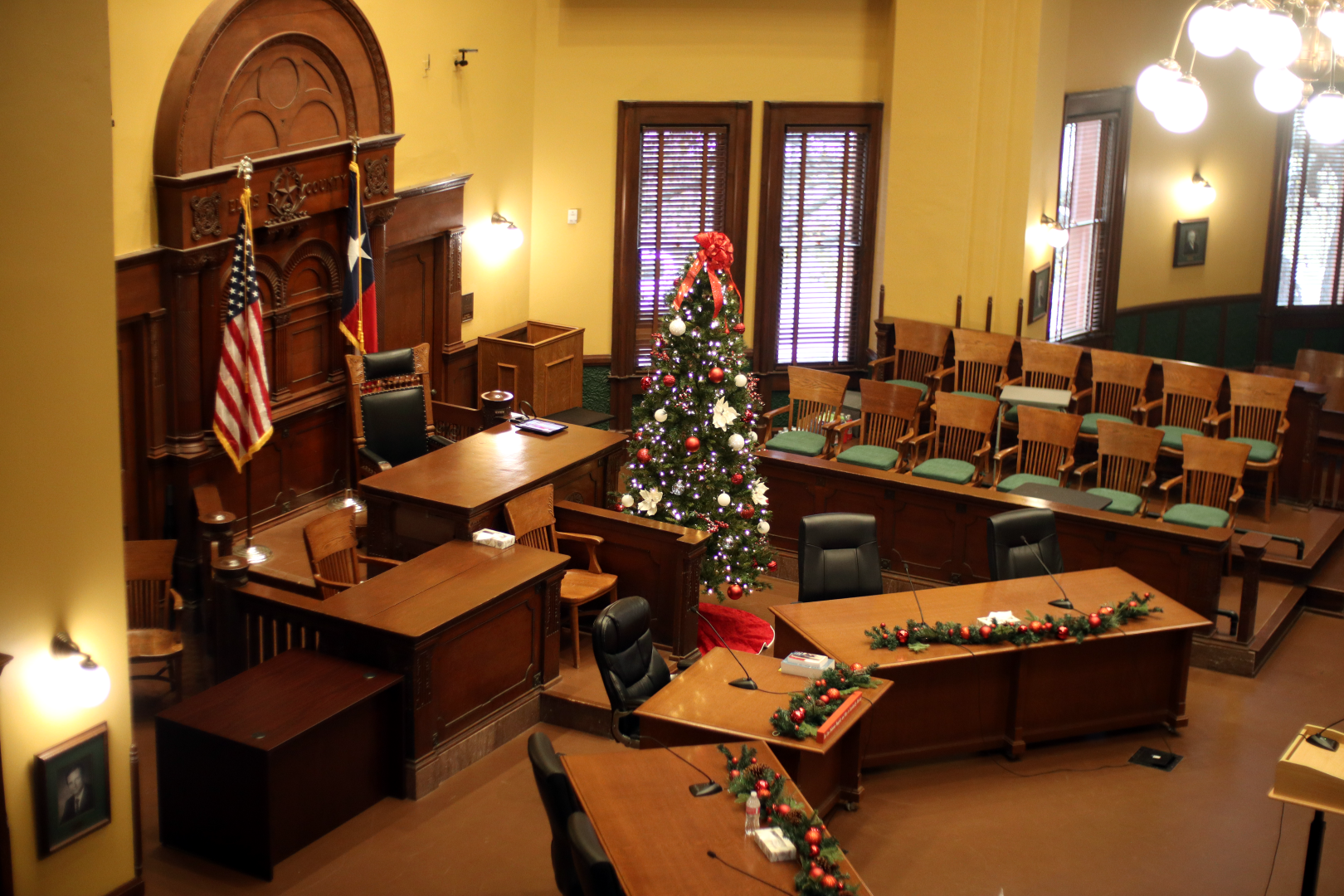
You are now entering the upper courtroom – the main interior feature of the Ellis County Historic Courthouse. This courtroom was home to the 40th District Court of Texas, covering Ellis County exclusively, from the time the Historic Courthouse was opened in 1897 until 2010. While Ellis County had originally hosted only the 40th District Court, population growth over time has necessitated the introduction of new courts with specialized jurisdiction to handle the increased number of trials. The Ellis County judicial system is presently comprised of three district courts, three county courts at law, and four justices of the peace – not all of which could share the two available courtrooms in this building. Thus, the Ellis County judicial system outgrew the Historic Courthouse, and the county built a new Courts & Administration Building on Jackson Street in 2010. Even so, the upper courtroom of the Historic Courthouse continues to be used today by the Ellis County Commissioners’ Court – the governing council of the county.
Do you happen to be a lawyer? If not, please enjoy a rare privilege by opening the gate in front of you and proceeding towards the judge’s bench – i.e. passing the bar. The Bar Exam was named after the traditional setup of courtrooms in which a physical bar existed to divide the audience from the trial area, where it was considered a privilege to be, under the discretion of the judge.
Presently, the desks in the courtroom face toward the audience; during Commissioners’ Court, the county commissioners prefer to engage the audience, and the County Judge sits amongst them, rather than at the judge’s bench. Historically, the courtroom desks would have instead faced toward the judge’s bench, with the prosecution on one side and the defense on the other. Stage right from the judge sat the District Clerk and/or Court Reporter, who kept detailed records of court proceedings. In front of the judge sat the witness, who faced the entire audience with the judge immediately behind his or her back in order to reinforce the significance of testifying under oath. Stage left from the judge sat the jury, who paid careful attention to the arguments of the prosecution and defense. And of course, a large audience sat to watch the trial. While this may seem intimidating by today’s standards, the traditional school of thought was that public trials would be the most fair trials – not to mention the fact that crime and punishment in small-town America was typically a communal event prior to 24/7 news coverage. Lastly, the judge’s chambers and prisoner stairwell were both located at stage left of the judge’s bench. Behind one of the doors in this recessed area, prisoners would be escorted into or out of the courtroom through a separate stairwell that wound in a circle, much like a lighthouse, all the way to the basement area where a temporary holding cell kept prisoners scheduled for trial on any given day.
This courtroom has often been referred to as a “To Kill a Mockingbird” courtroom – not in the negative sense of the tragic plot of that classic story, but based on the courtroom’s ability to invoke images of a bygone Southern society. Looking toward the audience, one can almost picture ladies fanning curls of hair underneath their sunhats, along with gentlemen leaning forward in their seats – tobacco pipes twisting left or right underneath their mustaches in sync with every piece of incriminating or vindictive evidence presented. One aspect of that bygone Southern Society that may not invoke nostalgia, however, would be racial segregation. It is likely that the courtroom balcony was “reserved,” to use a historic euphemism, for Blacks. When segregation ended, and when the county needed additional office space in the Historic Courthouse, this balcony area was extended across the top of the courtroom to connect with the top of the judge’s bench in order to create a third floor; note that the top of the judge’s bench still shows a seam today. During the 1998 courthouse restoration, these third floor offices were removed, and the balcony was reconstructed based on similar designs seen in other courthouses by James Reily Gordon. Apart from the balcony and reproduction audience seats, however, the rest of the courtroom is original.
Around the circumference of the courtroom, you will see portraits of every 40th District Court judge to serve Ellis County. Starting at the 1:00 position in the courtroom behind the jury box, you will see a portrait of Judge Oran Roberts. In the Texas Republic, many judicial officials were appointed, rather than elected as they are today. Roberts was appointed as a District Attorney by none other than President Sam Houston, after which he became the first 40th District Court Judge upon his appointment to that role by Governor James Henderson. Roberts went on to serve as a Justice on the Texas Supreme Court, the President of the 1861 Texas Secession Convention, and eventually the Governor of Texas from 1879 – 1883. Going clockwise through the other portraits, at the back right of the courtroom immediately before the entrance, you will see a portrait of Judge James Dillard, the first district judge to serve in this courtroom after the opening of the then-new Ellis County Courthouse. Continuing clockwise around the courtroom, you will end with Judge Gene Knize, the last district judge to serve his full tenure in this courtroom. The current district judge, Judge Bob Carroll, briefly served in this courtroom before the new Courts & Administration Building was opened in 2010.